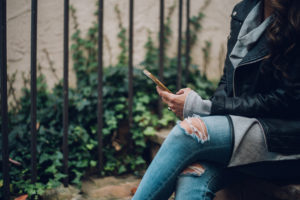Sexual Assault Reporting Apps: Perilous or Positive?

The rise of #MeToo and #TimesUp pushed sexual harassment and assault to the forefront of national and global conversations this year. Thanks to these movements, it isn’t as easy for our country to hide from its pattern of sexual abuse that exists within all of our institutions and communities. However, with all of the good that the #MeToo movement has done—and will continue to do—for survivors, a hashtag cannot single-handedly stop men from assaulting women—and men—and create a culture where victims feel comfortable reporting their abusers. There are apps for that.
According to the Rape, Abuse & Incest National Network (RAINN), an American is sexually assaulted every 98 seconds. Two out of three sexual assaults go unreported and only 6 out of 1,000 perpetrators go to prison. Victims of sexual harassment or assault are often stigmatized or shamed. Most victims do not report sexual assault because they fear retaliation or believe police would not do anything. They also may not want to relive their pain to an authority.
The sexual assault reporting apps on the market today focus on creating a space where victims of sexual violence feel comfortable submitting a report. Rather than going to an office in person, where many feel they might be judged or shamed, survivors can report an assault whenever and wherever they feel most comfortable. All they need to do is open an app and record a text, video, or audio message. The apps encrypt all reports so that the victim cannot change it after it’s been submitted, but they can decide whether it is transferred to the police immediately or held until more reports are submitted that accuse the same person. As one app, Callisto, puts it, “We might create a sea change if victims could learn that they are ‘not the only one.’”
There are many positive aspects of these apps. For survivors, holding onto a report until they are sure that others have experienced the same thing minimizes exposure, retaliation, and stigma, as well as lessens disbelief by authorities. Submitting a report through an app can also mitigate stigmas associated with gender and race, making it safer for TGQN (transgender, genderqueer, nonconforming) people and people of color to report sexual violence.
However, some of the biggest sexual assault reporting apps available today appear somewhat predatory. These apps mainly service academic institutions and employers that are under pressure to address sexual misconduct because of #MeToo. Companies and colleges must buy into Callisto, which NPR reports can cost anywhere from $10,000 to $30,000 a year. Apps that serve individuals rather than institutions, like JDoe, are free, but make money by charging attorneys $1,000 a year to access survivor reports that may lead to potentially lucrative civil claims.
Some apps, like What-About-No (available in the app store for $5 a year), expect people to pull out their phone in the middle of a sexual assault, scroll through their phone to find the app, wait for it to load, and press a button that will play a video of a police officer who states, “You were told NO! A video of that no message has been recorded and saved. What is it about the word no that you do not understand? No means No! A video of you watching this ‘No’ message has been safely uploaded to the cloud.” Not only is this unrealistic (and inappropriately silly), it could escalate the situation and be potentially dangerous for the victim. In a time when women who threaten to call the police on men who harass them while they are out jogging are abducted and murdered, is this app a suitable solution?
In addition to being inherently exploitative, these apps are capable of amassing large amounts of potentially unsubstantiated discoverable data and placing it in the hands of a private company. If you’re thinking that the apps inherently pray on victims’ trauma for monetary gain, you might not be too far from the mark.
Not all of these apps can be painted with the same predatory and potentially dangerous broad brush. One great option is Circle of Six. Free to download, Circle of Six makes it quick and simple to reach six pre-programmed emergency contacts. The user has the option to request a contact pick them up at their GPS coordinates, call the user to act as an interruption, or send chat messages to the user. The app also hosts links to information about sexuality, relationships, and safety, and provides direct access to national hotlines.
Circle of Six seems to be an outlier in an ever-growing market of sexual assault apps in the age of #MeToo. While some services need to charge clients in order to continue to provide their service, what populations do these apps serve? Should we be teaching women that in order to be truly safe they must have their smart phone on them at all times, pay for an app, and remember to use it—especially when it may not even be accessible for some people? When done correctly, these apps could have great potential, but they cannot truly replace education, prevention, destigmatizing, and a commitment to creating structures within our own institutions and communities that allow for survivors to comfortably report an assault. Instead of exploiting trauma and fear for monetary gain, we should continue to engage in discourse in order to change our social constructs of gender so that men don’t feel entitled to the attention and bodies of others, and become violent next time they are told “no.”
